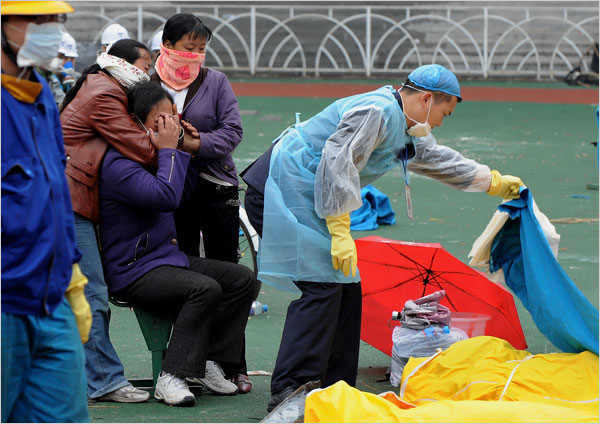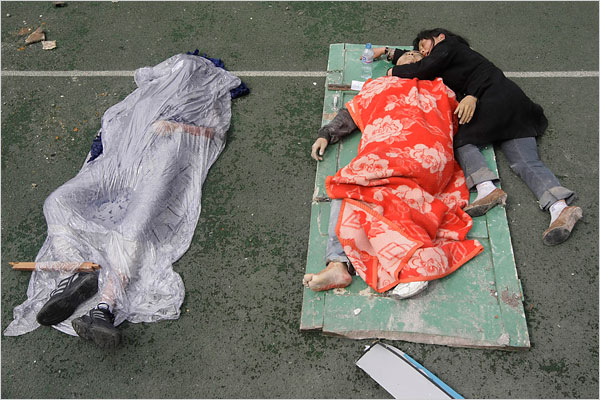I’m not sure why, but the photos from China that have been devastating. Disaster coverage is familiar to everyone–whether it’s twisted wreckage or a bloated corpse, long lines of refugees or supplies stacked on the tarmac, we’ve seen it before. And we’ve seen people crying over lost homes, villages, loved ones. But somehow not like this:
Can a photograph be more tender, or more heartbreaking? The contrasts only make everything worse by underscoring deeper similarities. He looks as if he still could be alive, but he is as dead as the hardening body shrouded next to him. His covering is colorful, alive with color, but that only marks the vitality that has been lost. She holds him so lovingly, as if they had fallen asleep in each others’ arms, but she will never hold him again.
Nor is she alone in her loss. There are many images of parents, sisters, friends, stricken in their grief. Like this:

This woman has just identified a loved one. The shock is palpable–a heavy body blow driving her into herself. (The English word “grief” derives from the Latin gravis, heavy.) Her hands claw at her face, as if to scratch out her eyes. Other friends or family are with her, holding her, yet she is inconsolable.
This photograph is less elemental than the first. Instead, it is cluttered with signs of the public character of the disaster. A uniformed emergency worker fusses with tarps and other material while overseeing the body bags. The background suggests some public venue (a stadium?) and a stranger walks by on his own business. The informal masks, which are an indication of mass death, also signify the anonymity that divides private lives and public interaction. And that’s where we come in: anonymous spectators far away from those whose lives are being ripped apart in full view of the world press. Some writers on photography are appalled by the visual mediation of suffering, and they could describe these images as a voyeuristic indulgence in false sentiments that deaden genuinely ethical relationships.
And they would be wrong.
Second photograph by Mark Ralston/AFP-Getty Images; I misplaced the credit for the first photo but hope it will turn up. (If anyone can let me know, it would be much appreciated.)

[…] Check it out here. […]
Grief is an immense emotion. I personally have not yet suffered the sudden and wrenching loss of a loved one, but I have seen people just as close to me go through this pain. It cuts so deeply it is palpable. These pictures go some way toward illustrating this.
photography studios…
Good websites are few and far between; yours is a pleasure to visit; bookmarking for future visits and I enthusiastically recommend the same!…